Study on the Factors Affecting the Humus Horizon Thickness in the Black Soil Region of Liaoning Province, China
Abstract
1. Introduction
2. Materials and Methods
2.1. The Study Area
2.2. Data Acquisition
2.2.1. Data Sources
- (1)
- (2)
- The environmental variables were average annual temperature, land use type, DEM, vegetation type, geomorphology, and annual precipitation (Figure 2).
2.2.2. Data Processing
- (1)
- The defining characteristic of soil in the black soil region is the existence of a black or dark black humus horizon, typically designated by letter A [2,3]. The thickness directly indicates the soil’s fertility and quality [2]. Therefore, in order to evaluate the HHT, the thickness of horizon A was selected as the measurement standard. Predicting the thickness of horizon A allows for a more precise assessment of the fertility status, providing crucial data support for agricultural production and soil management.
- (2)
- In ArcGIS, the reclassification tool can reclassify various data based on specific rules. Following reclassification, 122 samples were determined. To validate the delineated black soil region and assess its accuracy, 85 samples were randomly selected, while the remaining 37 samples were used as validation points. These validation points were chosen to evaluate the accuracy of the study results through comparative analyses.
2.3. Research Methods
2.3.1. Ordinary Kriging
- (1)
- Calculation the distance and semi-variance: calculate the distance between known points is calculated to obtain the corresponding semi-variance.
- (2)
- Fitting the semi-variance function: a curve is chosen to fit the relationship between semi-variance and distance. This relationship is usually expressed through variational function models, including Gaussian, linear, spherical, damped sine, and exponential models.
- (3)
- Determine the range: a range is a specific distance within which attribute values are spatially correlated. Beyond this distance, the attribute values are no longer correlated.
- (4)
- Calculation of weights: for an unknown point, its distance from a known point within the variation is calculated and the semi-variance of the response is derived, which in turn back-calculates the weights (λ).
- (5)
- Performing interpolation: Using the weights (λ) and the attribute values of the known points, the attribute values of the unknown points are calculated by a linear unbiased and optimal estimation method. The formula is as follows.
2.3.2. Inverse Distance Weight Interpolation
2.3.3. Regression Kriging Interpolation
- (1)
- Constructing regression model: Sample data and factors (Vegetation type, Land use type, Average annual temperature, Annual precipitation, DEM (m), and Geomorphology) were used to construct regression model, and extract the main trend of data.
- (2)
- Calculation residuals: Following the construction of the regression model, residuals are computed for each sample point. These residuals represent the discrepancies between the observed values and the predicted values derived from the regression model.
- (3)
- Ordinary kriging interpolation: The calculated residuals are interpolated using the ordinary kriging method to ensure the spatial correlation of the data is fully incorporated.
- (4)
- Combining trend terms and residuals: The final spatial interpolation results are obtained by integrating the trend terms derived from the regression model and the findings from the ordinary kriging interpolation analysis of the residuals.
- (5)
- A multiple regression model was used to fit the HHT distribution map to visualize the interpolation results and their spatial distribution.
2.3.4. Random Forest Model
2.3.5. Model Performance Assessment
2.3.6. Cross Validation
2.3.7. Data Histogram
2.3.8. Data Analysis
3. Results
3.1. Statistical Characteristics of HHT
3.2. Spatial Distribution Characteristics of HHT
3.3. Suitability Evaluation of Different Interpolation Methods
3.4. Factors Influencing the Humus Horizon Thickness
- (1)
- The independent variable, mean annual temperature, occupied the largest share in the model at 28.56%, indicating that mean annual temperature had the highest influence and was a key factor in model construction.
- (2)
- The weight of average annual precipitation was 27.38%, indicating that it also had an important influence.
- (3)
- DEM had a weighting of 21.12%, which was smaller than the mean annual temperature and precipitation, and had a relatively small degree of influence in the model.
- (4)
- The proportion of land use types is 12.00%, which has a moderate influence, which means that among the variables considered, it has certain explanatory power to predict the HHT.
- (5)
- The proportion of geomorphology was 5.70%, and the contribution was low. It showed that geomorphic factors were not the main factors.
- (6)
- The proportion of vegetation types was 5.20%, with the lowest contribution. This showed that the change of vegetation type was not the main influencing factor, or its influence was relatively weakened compared with other factors.
4. Discussion
4.1. Characterizing the Spatial Variability of Humus Horizon Thickness
4.1.1. Selection of Interpolation Methods
4.1.2. Accuracy of Interpolation Methods
4.2. Characterization Results of Spatial Variability of Humus Horizon Thickness
4.2.1. Characteristics of Spatial Distribution of Humus Horizon Thickness
4.2.2. Variability in the Spatial Distribution of Humus Horizon Thickness
- (1)
- Environmental sensitivities: The humus horizon is highly sensitive to environmental changes and is susceptible to factors such as climate change and topographical differences. When environmental conditions change, soil organisms, microorganisms, enzymes, and other chemical substances are all affected in some way, thus influencing the black soil evolution process [61]. Liaoning Province has a temperate monsoon climate, with relatively high precipitation in the eastern coastal areas under the influence of the sea. The inland areas in the northwest have a gradual decrease in precipitation, and the variability of climate distribution leads to different degrees of erosion of the humus horizon [36,58]. Liaoning has a diverse topography, and as one of the natural geographic elements, it plays an important role in the redistribution of water and organic matter on the surface. Under different topographic conditions, there are significant differences in the migration, accumulation, and loss patterns of water and organic matter, which directly affect the formation and development of soil layers [59]. Liaoning Province has a rich variety of landform types, ranging from the mountainous hills in the east to the Liaohe Plain in the center to the Bohai Coastal Plain in the west, and these different topographic features have a profound impact on the distribution of water and organic matter [36]. In mountainous areas, the large slope and fast surface runoff rate easily lead to soil erosion [36], making it difficult for organic matter to accumulate in the surface layer, thus affecting the development of the humus horizon [36]. In contrast, in plain areas, the flat topography helps the accumulation of water and organic matter in the top layer of soil, which is conducive to the formation of a thicker humus horizon [59]. At the same time, there are also variations in precipitation across different regions. For instance, Dalian in the southeast receives abundant precipitation, while the northwestern region experiences relatively less. This precipitation gradient also influences soil moisture and organic matter content, further intensifying the spatial variability of HHT [6,54].
- (2)
- The soil-forming parent material of Liaoning Province is mainly influenced by its geological structure and rock types, and the soil formation conditions and history of different regions are different [36,60]. Black soils exhibit varying thicknesses across various regions, types, and development stages within the same region, due to differences in soil mineral composition, combination patterns of soil-forming factors, and interaction intensity [62,63]. The formation of soil is significantly influenced by the types of parent materials, which determine the initial material composition and texture of soil. The soil-forming parent materials are complex and diverse, primarily comprising loess, loess-like materials, alluvial deposits, and floodplain deposits [36]. Due to the differences in the type and distribution of these soil-forming materials, the soil properties are unevenly distributed in space. For example, thick humus horizon may be formed in loess and loess-like material sediment areas, while fertile paddy soil may be formed in alluvial areas for good drainage conditions.
- (3)
- Anthropogenic activity: Several anthropogenic factors play different roles leading to significant differences in the spatial distribution of humus thickness [36]. These factors include land-use practices and soil management measures. The Bohai Coast in the south and the plains in the north-central part of Liaoning Province are the main grain production bases. These areas generally adopt more scientific management methods in land use [1,6]. For instance, conservation tillage techniques, such as straw return and no-tillage sowing, are widely promoted in Northeast China. These techniques have effectively slowed down soil erosion and maintained the organic matter content and structural stability of the soil. These conservation tillage techniques reduce direct soil exposure and the impact of weathering. They also help maintain the HHT by increasing soil organic matter and enhancing the soil’s resistance to erosion and self-recovery. In contrast, the southeastern part is predominantly hilly. This results in a fragmented distribution of arable land, uneven implementation of management measures, and difficult management. Long-term agricultural cultivation and irrational land management practices have significantly impacted the humus horizon. Excessive ploughing, fertilizer use, and single crop planting patterns have damaged the soil structure and accelerated the decomposition of soil organic matter. This has led to the gradual thinning of the humus horizon. Furthermore, with the advancement of urbanization in southeastern part, arable land has been heavily used for industrial and residential construction. This not only reduces the area of arable land but also further destroys the soil structure through construction activities. The changes in land use have directly affected soil protection and recovery mechanisms, making it more difficult to maintain the originally weak humus horizon. Industrial emissions and improper treatment of wastewater may potentially lead to soil pollution, affecting the quality and fertility of the humus horizon.
5. Conclusions
- (1)
- In the study of predicting the spatial distribution of humus horizon thickness, the regression kriging generates relatively smooth images with good visualization and shows a significant advantage over other methods in terms of accuracy. Ordinary Kring may not be able to reach the accuracy level of regression kriging without introducing additional environmental variables. Inverse distance weight interpolation is too simple and relies only on the weights of distances, resulting in its inability to accurately reflect the actual situation in some cases.
- (2)
- The humus horizon thickness fluctuates greatly in spatial distribution and is easily affected by the changes of surrounding environment. Among the six environmental variables selected for this study, mean annual temperature, mean annual precipitation, and DEM are key influencing factors (with a contribution sum of 77.07%) of the humus horizon thickness.
- (3)
- The thickness of the humus horizon in Liaoning Province exhibits an increasing trend from the southeast towards the central and northern directions, with the thinnest horizons found in the southeast. Conversely, the northeast and southwest regions have relatively thicker horizons. Along the Bohai Sea in the south, the humus horizon is thicker but not densely distributed. Chaoyang and Fuxin, located in the northwestern direction, belong to the area with thicker humus horizons, although the distribution of black soil is scattered. Meanwhile, places such as Tieling in the northeastern direction have thick humus horizons and exhibit an aggregated distribution, albeit covering a relatively small area.
Author Contributions
Funding
Data Availability Statement
Acknowledgments
Conflicts of Interest
List of Acronyms
| Acronym | Definition |
| HHT | humus horizon thickness |
| OK | ordinary kriging interpolation |
| IDW | inverse distance weighted interpolation |
| RK | regression kriging interpolation |
| ME | mean error |
| MAE | mean absolute error |
| RMSE | root mean square error |
| RRMSE | relative root mean square error |
| DEM | digital elevation model |
| CV | coefficient of variation |
References
- Han, X.Z.; Zou, W.X. Effects and suggestions of black soil protection and soil fertility increase in Northeast China. Bull. Chin. Acad. Sci. 2018, 33, 206–212. [Google Scholar]
- Gong, Z.T.; Zhang, G.L. Pedogenesis and Soil Taxonomy; Science Press: Beijing, China, 2007. [Google Scholar]
- IUSS Working Group WRB. World Reference Base for Soil Resources. International Soil Classification System for Naming Soils and Creating Legends for Soil Maps, 4th ed.; International Union of Soil Sciences (IUSS): Vienna, Austria, 2022. [Google Scholar]
- Xie, L.Y.; Ren, L.H.; Shi, L.K.; Du, C.S. Soil and water loss and anti-erosion countermeasures in Chernozem region of Liaoning Province. Bull. Soil Water Conserv. 2005, 25, 92–95. [Google Scholar]
- Lv, Z.X. Exploration of the sustainable use of sloping arable land in black soil erosion areas. Agro Environ. Dev. 1997, 54, 31–32. [Google Scholar]
- Zhang, X.Y.; Liu, X.B. Key issues of mollisols research and soil erosion control strategies in China. Bull. Soil Water Conserv. 2020, 40, 340–344. [Google Scholar]
- Jiang, Y.; Wang, J.; Yang, J.W. Research progress analysis of black soil region cultivated land quality evaluation index by remote sensing. Eng. Surv. Mapp. 2023, 32, 1–13. [Google Scholar]
- Žížala, D.; Juřicová, A.; Zádorová, T.; Zelenková, K.; Minařík, R. Mapping soil degradation using remote sensing data and ancillary data: South-East Moravia, Czech Republic. Eur. J. Remote Sens. 2019, 52 (Suppl. S1), 108–122. [Google Scholar] [CrossRef]
- Drewnik, Z. Properties and classification of heavily eroded post-chernozem soils in Proszowice Plateau (southern Poland). Soil Sci. Annu. 2019, 70, 225–233. [Google Scholar] [CrossRef]
- Meng, K.; Zhang, X.Y. Mechanisms of black soil degradation in the Songnen Plain and its ecological restoration. Chin. J. Soil Sci. 1998, 29, 100–102. [Google Scholar]
- Matecka, P.; Świtoniak, M. Delineation, characteristic and classification of soils containing carbonates in plow horizons within young moraine areas. Soil Sci. Annu. 2020, 71, 23–36. [Google Scholar] [CrossRef]
- Liu, K.; Dai, H.M.; Liu, G.D.; Wei, M.G.; Yang, J.J. Spatial analysis of land use change effect on soil organic carbon stocks in Sanjiang Plain of China between1980 and 2016. Acta Geol. Sin. 2019, 93 (Suppl. S1), 130–131. [Google Scholar] [CrossRef]
- Song, Y.; Liu, K.; Dai, H.; Zhang, Z.; Zhao, J.; Yang, J.J.; Wei, M. Spatio-temporal variation of total N content in farmland soil of Songliao Plain in Northeast China during the past 35 years. Geol. China 2021, 48, 332–333. [Google Scholar]
- Liu, G.D.; Li, L.J.; Dai, H.M.; Xu, J. Change in soil carbon pool in Songliao Plain and its cause analysis. Geophys. Geochem. Explor. 2021, 45, 1109–1120. [Google Scholar]
- Bu, C.; Cai, Q.; Zhang, X.; Ma, L. Review on development characteristics and ecological functions of soil crust. Prog. Geogr. 2008, 27, 26–31. [Google Scholar]
- Wei, D.; Kuang, E.; Chi, F.; Zhang, J.; Guo, W. Status and protection strategy of Black soil resources in Northeast China. Heilongjiang Agric. Sci. 2016, 1, 158–161. [Google Scholar]
- Han, X.; Li, N. Research Progress of Black Soil in Northeast China. Sci. Geogr. Sin. 2018, 38, 1032–1041. [Google Scholar]
- Taylor, A.; Blum, J.D. Soil age and silicate weathering rates deter-mined from the chemical evolution of a glacial chronosequence. Geology 1995, 23, 979–982. [Google Scholar] [CrossRef]
- Duan, X.W.; Xie, Y.; Ou, T.; Lu, H. Effects of soil erosion on long-term soil productivity in the black soil region of northeastern China. Catena 2011, 87, 268–275. [Google Scholar] [CrossRef]
- Alexandra, K.; Bullock, D.G. A comparative study of interpolation methods for mapping soil properties. Agron. J. 1999, 91, 393–400. [Google Scholar]
- Yang, S.H.; Zhang, H.T.; Guo, L.; Ren, Y. Spatial interpolation of soil organic matter using regression Kriging and geographically. Chin. J. Appl. Ecol. 2015, 26, 1649–1656. [Google Scholar]
- Xu, Y.L.; Luo, M.L.; Liang, B.Y.; Chang, X.L.; Xiang, W.; Zhang, B. Effects of different DEM spatial interpolation methods on soil erosion simulation: A case study of a typical gully of dry-hot valley based on USPED. Prog. Geogr. 2016, 35, 870–877. [Google Scholar]
- Wang, X.M.; Fan, C.; Gao, B.B.; Ren, Z.P.; Li, F. A spatial random forest interpolation method with semi-variogram. Chin. J. Eco-Agric. 2022, 30, 451–457. [Google Scholar]
- Zhang, G.L.; Wang, Q.B.; Han, C.L.; Sun, F.J.; Sun, Z.X. Soil Series of China-Liaoning Volume; Science Press: Beijing, China, 2020. [Google Scholar]
- Office of National Soil Survey. China Soil Species; China Agricultural Publishing House: Beijing, China, 1994; Volume 2. [Google Scholar]
- Jing, S.C. Debris Flow Prediction Model Based on Bayes Discriminant Analysis in Sichuan Province; University of Electronic Science and Technology of China: Chengdu, China, 2013. [Google Scholar]
- Mueller, T.G.; Dhanikonda, S.R.K.; Pusuluri, N.B.; Karathanasis, A.D.; Mathias, K.K.; Mijatovic, B.; Sears, B.G. Optimizing inverse distance weighted interpolation with cross-validation. Soil Sci.. 2005, 170, 504–515. [Google Scholar] [CrossRef]
- Knotters, M.; Brus, D.J.; Voshaar, J. A comparison of kriging, co-kriging and kriging combined with regression for spatial interpolation of horizon depth with censored observations. Geoderm 1995, 67, 227–246. [Google Scholar] [CrossRef]
- Liess, M.; Hitziger, M.; Huwe, B. The Sloping Mire Soil-Landscape of Southern Ecuador: Influence of Predictor Resolution and Model Tuning on Random Forest Predictions. Appl. Environ. Soil Sci. 2014, 2014, 57–66. [Google Scholar] [CrossRef]
- Castro-Franco, M.; Costa, J.L.; Peralta, N.; Aparicio, V. Prediction of Soil Properties at Farm Scale Using a Model-Based Soil Sampling Scheme and Random Forest. Soil Sci. 2015, 180, 74–85. [Google Scholar] [CrossRef]
- Yang, Y.Q.; Yang, L.A.; Ren, L.; Li, C.L.; Zhu, Q.E.; Wang, T.T.; Li, X.R. Prediction for spatial distribution of soil organic matter based on random forest model in cultivated area. Acta Agric. Zhejiangensis 2018, 30, 1211–1217. [Google Scholar]
- Zhang, Z.Q.; Yu, F.Z. Study on the Application of Soil Type Information in Spatial Prediction of Soil Organic Carbon. Chin. Agric. Sci. Bull. 2013, 29, 139–144. [Google Scholar]
- Jin, L.; Heap, A.D.; Potter, A.; Daniell, J.J. Application of machine learning methods to spatial interpolation of environmental variables. Environ. Model. Softw 2011, 26, 1647–1659. [Google Scholar]
- Wu, T. Remote Sensing Characterization of Soil Erosion Intensity and Its Impact on the Spatial Pattern of Cropland Carbon Sequestration Potential in the Degraded Black Soil Region; Jilin University: Changchun, China, 2024. [Google Scholar]
- Gao, F.J.; Ma, Q.L.; Han, W.W.; Shan, P.M.; Zhou, J.; Zhang, S.L.; Zhang, Z.M.; Wang, H.Y. Spatial Variability and Distribution Pattern of Soil Organic Matter in a Mollisol Watershed of China. Environ. Sci. 2016, 37, 1915–1922. [Google Scholar]
- Jia, W.J. Liaoning Soil; Liaoning Science and Technology Press: Shenyang, China, 1992. [Google Scholar]
- Yang, M.X. Evaluating Rainfall Interpolation over the Netherlands; Chang’an University: Xi’an, China, 2015. [Google Scholar]
- Li, Y.; E, S.Z.; Zhao, T.X.; Yuan, J.H.; Liu, Y.N.; Lu, G.B.; Zhang, P. Research Progress on Digital Soil Mapping Methods. Chin. Agric. Sci. Bull. 2024, 40, 146–153. [Google Scholar] [CrossRef]
- Lu, H.L. Comparison of Digital Soil Mapping Methods Based on Feature Selection and Different Machine Learning; Anhui University of Science and Technology: Huainan, China, 2020. [Google Scholar]
- Sun, F.J.; Lei, Q.L.; Liu, Y.; Li, F.L.; Wang, Q.B. Research progress and prospect of digital soil mapping technology. Chin. J. Soil Sci. 2011, 1502–1507. [Google Scholar]
- Liu, Y.J.; Wu, H.Q.; Li, R.; Hao, J.D.; Zhu, L. Study on the Distribution Characteristics of Effective Soil Thickness of Cultivated Land in Tacheng City Based on GIS. Geopatial Inf. 2023, 21, 58–62. [Google Scholar]
- Zhao, J.J.; Zhang, H.Y.; Wang, Y.Q.; Qiao, Z.H.; Hou, G.L. Research on the Quality Evaluation of Cultivated Land in Provincial Area Based on AHP and GIS: A Case Study in Jilin Province. Chin. J. Soil Sci. 2012, 70–75. [Google Scholar]
- Bao, G.J.; Ji, C.; Hou, D.W.; Li, Z.F.; Deng, A.P. Source Apportionment and Response to Landscape Pattern of Health Risk of Cultivated Soil Heavy Metals. Environ. Sci. 2024, 45, 4780–4790. [Google Scholar]
- Yuan, L.; Cao, W.J.; Yang, G.X.; Zhang, L.L.; Mu, X.L. Analysis on the Spatial-temporal Evolution of XCO2 in the Three Gorges Reservoir Region Based on OCO-2 Satellite. Spacecr. Recovery Remote Sens. 2022, 43, 141–151. [Google Scholar]
- Li, Z.Y.; Wei, X.H.; Li, B.S.; Guan, G.Z.; Xu, X.Z.; Lei, L. Spatial Distribution of Soil Calcium on Natural Slope of Karst Peak-cluster in Northern Guangdong Province. Bull. Soil Water Conserv. 2016, 36, 62–68. [Google Scholar]
- Yang, Y.X.; Guo, Y.P.; Zhang, H.; Zhang, L.H.; Sang, J. Interpolation Method of Arable Land Quality Grading Based on Barrier Factors. Trans. Chin. Soc. Agric. Mach. 2019, 50, 157–165+175. [Google Scholar]
- Xie, M.Y.; Wang, Y.; Kang, Y.; Wu, Z.T.; Chen, L.Q.; Liu, Q.; Wu, C.Y.; Zhang, J.M. Study of Spatial Predicting in Soil Attributes Based on Interpolations by Artificial Neural Net-work and Ordinary Kriging. J. Ecol. Rural. Environ. 2021, 37, 934–942. [Google Scholar]
- Zhang, C.R. Study on Chestnut Soil Tier Thickness Model in the Typical Grassland; Inner Mongolia Agricultural University: Hohhot, China, 2008. [Google Scholar]
- Guo, J.H.; Liu, F.; Xu, S.X.; Gao, L.L.; Zhao, Z.D.; Hu, W.Y.; Yu, D.S.; Zhao, Y.G. Comparison of digital mapping methods for the thickness of black soil layer of cultivated land in typical black soil area of Songnen Plain. J. Geo-Inf. Sci. 2024, 26, 1452–1468. [Google Scholar]
- Liu, R.X.; Wang, Z.Q.; Tan, Y.P. The thickness of black soil layer and its influencing factors in a small watershed of typical black soil region in Northeast China. J. Soil Water Conserv. 2024, 38, 346–353, 361. [Google Scholar]
- Liu, K.; Wei, M.H.; Dai, H.M.; Liu, G.D.; Jia, S.H.; Song, Y.H. Spatiotemporal Variation of Black Soil Layer Thickness in Black Soil Region of Northest China. Geol. Resour. 2022, 31, 434–442. [Google Scholar]
- Zhang, X.R.; Jiao, J.Y. Formation and evolution of black soil. J. Jilin Univ. 2020, 50, 553–568. [Google Scholar]
- Chen, Z.Z.; Liu, Y.H. Causes and Hazards of Soil Erosion in the Black Soil Area of Bin County and Measures for its Prevention and Control. Heilongjiang Sci. Technol. Water Conserv. 2009, 4, 240–241. [Google Scholar]
- Meng, X.Z.; Liu, T.; Wang, J.H. A Review of Soil Erosion Research in China’s Black Soil Area. China Rural. Water Hydropower 2010, 10, 36–41. [Google Scholar]
- Zhang, Z.Q.; Cai, H.W.; Zhang, P.P.; Wang, Z.L.; Li, T.T. A GEE-based study on the temporal and spatial variations in the carbon source/sink function of vegetation in the Three-River Headwaters region. Remote Sens. Nat. Resour. 2023, 35, 231–242. [Google Scholar]
- Miao, C.Y.; He, T.H.; Yuan, J.J.; Liu, D.Y.; Yao, R.J.; Ding, W.X. Effects of partial substitution of chemical fertilizer with organic fertilizer on soil organic carbon and sunflower yield in Hetao Irrigation Area. J. North. Agric. 2024, 52, 46–54. [Google Scholar]
- Gao, Y. Study on the Distribution Characteristics of the Composition and Properties of Black Soil Humus with Two Parent Materials; Jilin Agricultural University: Changchun, China, 2019. [Google Scholar]
- Wang, Z.Y.; Fu, Y.R.; Zou, B.Z.; Su, X.P.; Wang, S.R.; Wan, X.H. Dynamics Study on Soil and the Characteristics of Under story Vegetation Under Different Restoration Modes in Subtropical Forests. Fujian Agric. Sci. Technol. 2021, 52, 7–16. [Google Scholar]
- Li, J.; Liu, Y.R.; He, J.Z.; Zheng, Y.M. Insights into the responses of soil microbial community to the environmental disturbances. Acta Sci. Circumstantiae 2013, 33, 959–967. [Google Scholar]
- Pan, Y.; Peng, H.; Xie, S.; Zeng, M.; Huang, C. Eight Elements in Soils from a Typical Light Industrial City, China: Spatial Distribution, Ecological Assessment, and the Source Apportionment. Int. J. Environ. Res. Public Health 2019, 16, 2591. [Google Scholar] [CrossRef]
- Usowicz, B.; Lipiec, J. Spatial variability of saturated hydraulic conductivity and its links with other soil properties at the regional scale. Sci. Rep. 2021, 11, 8293. [Google Scholar] [CrossRef]
- Suleymanov, A.; Komissarov, M.; Asylbaev, L.; Khasanov, A.; Khabirov, L.; Suleymanov, R.; Gabbasova, L.; Belan, L.; Tuktarova, L. Spatial Variations of Genetic Horizons Thicknesses and Erosion Degree Assessment in Temperate Soils. Environ. Process. 2024, 11, 44. [Google Scholar] [CrossRef]
- Li, R.; Hu, W.; Jia, Z.; Liu, H.; Zhang, C.; Huang, B.; Yang, S.; Zhao, Y.; Zhao, Y.; Shula, M.K.; et al. Soil degradation: A global threat to sustainable use of black soils. Pedosphere 2024, 2010, 87–97. [Google Scholar] [CrossRef]
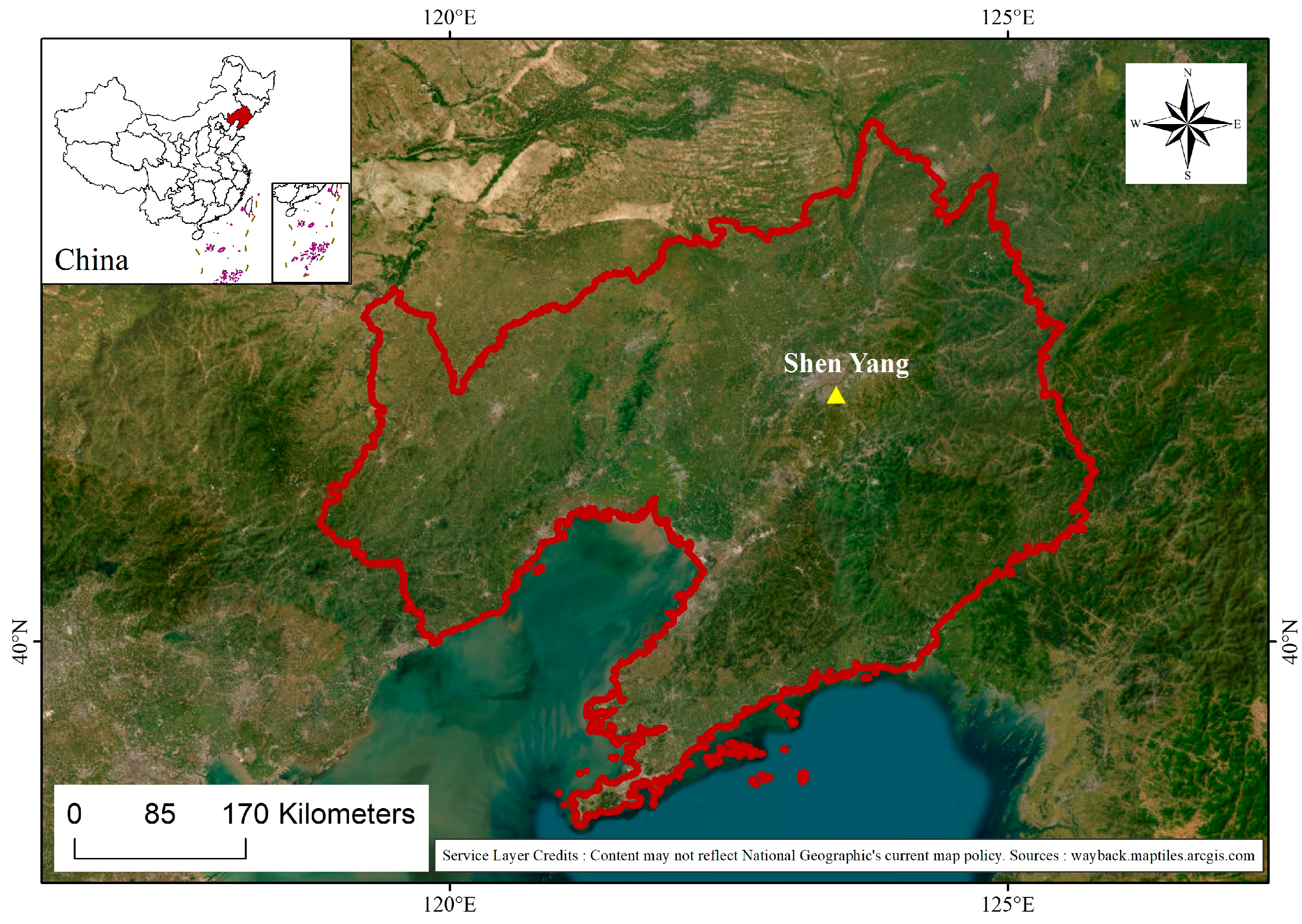
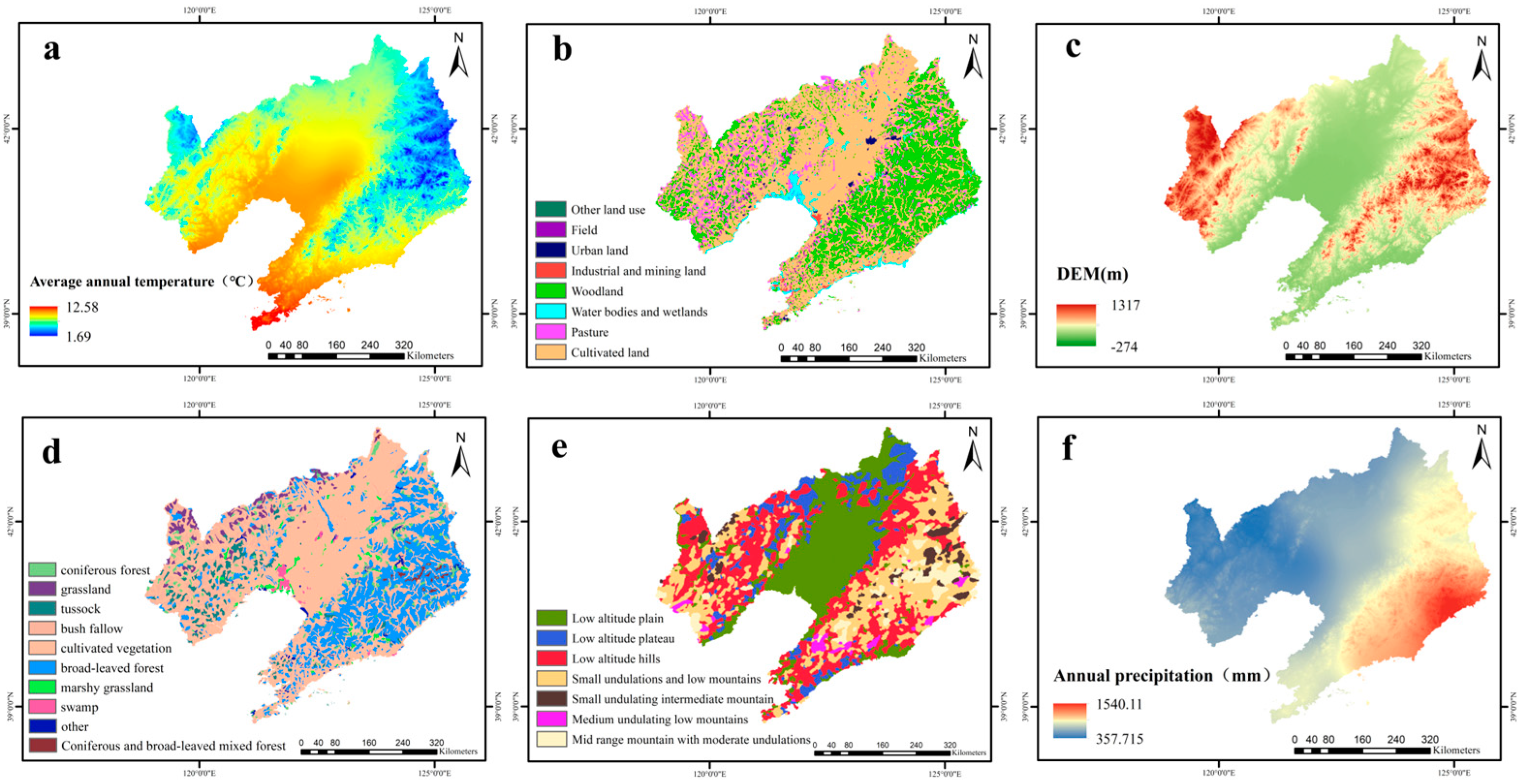
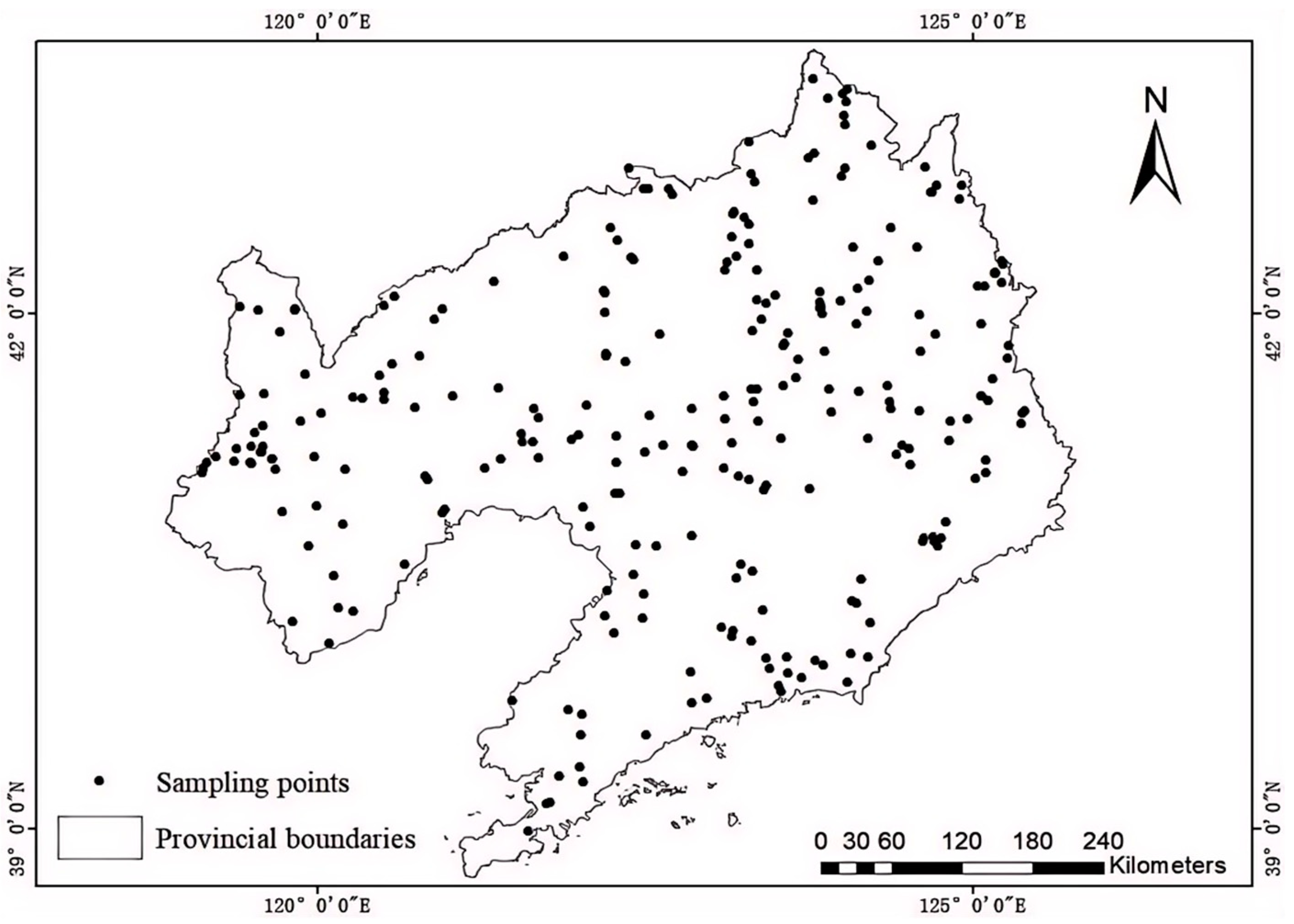
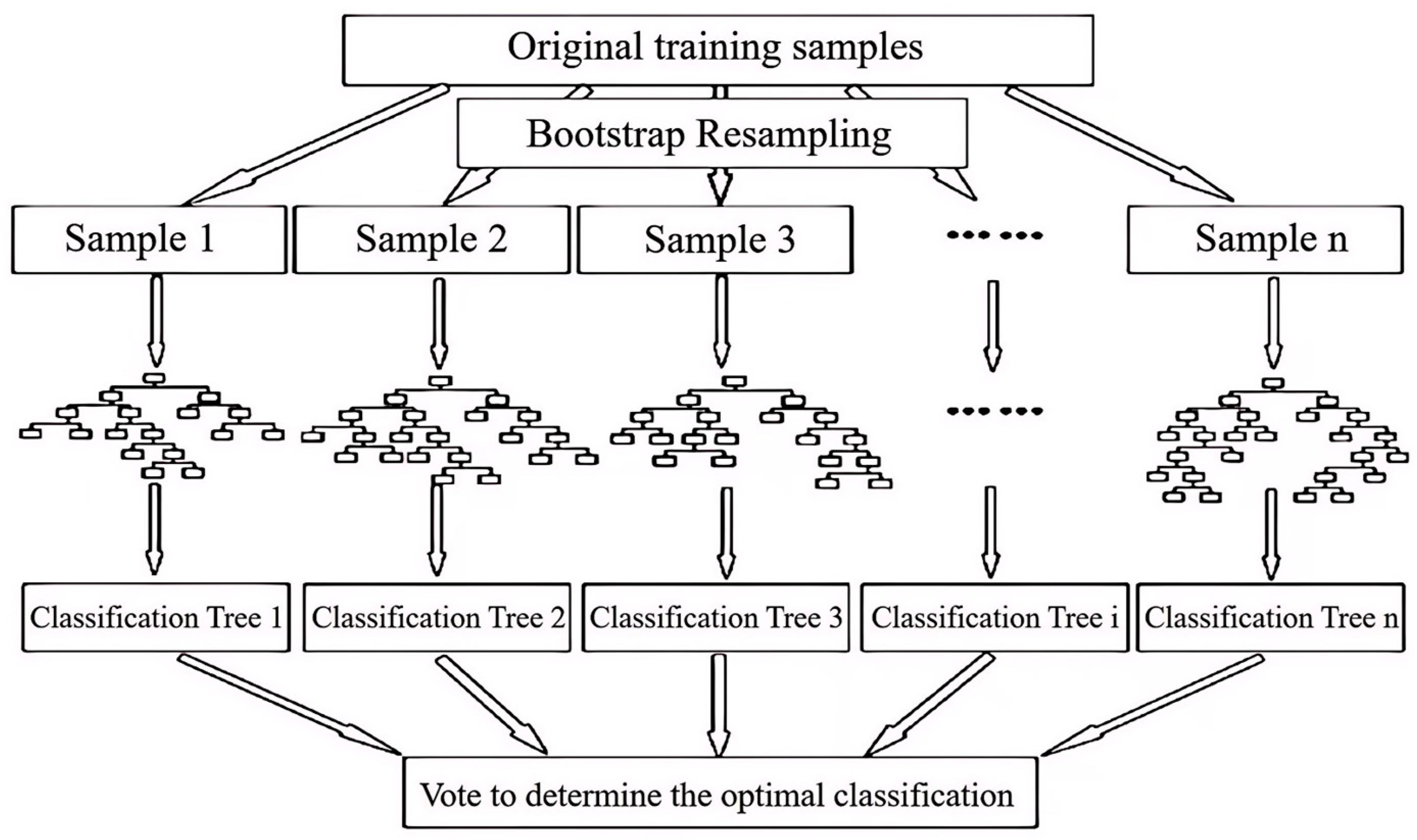
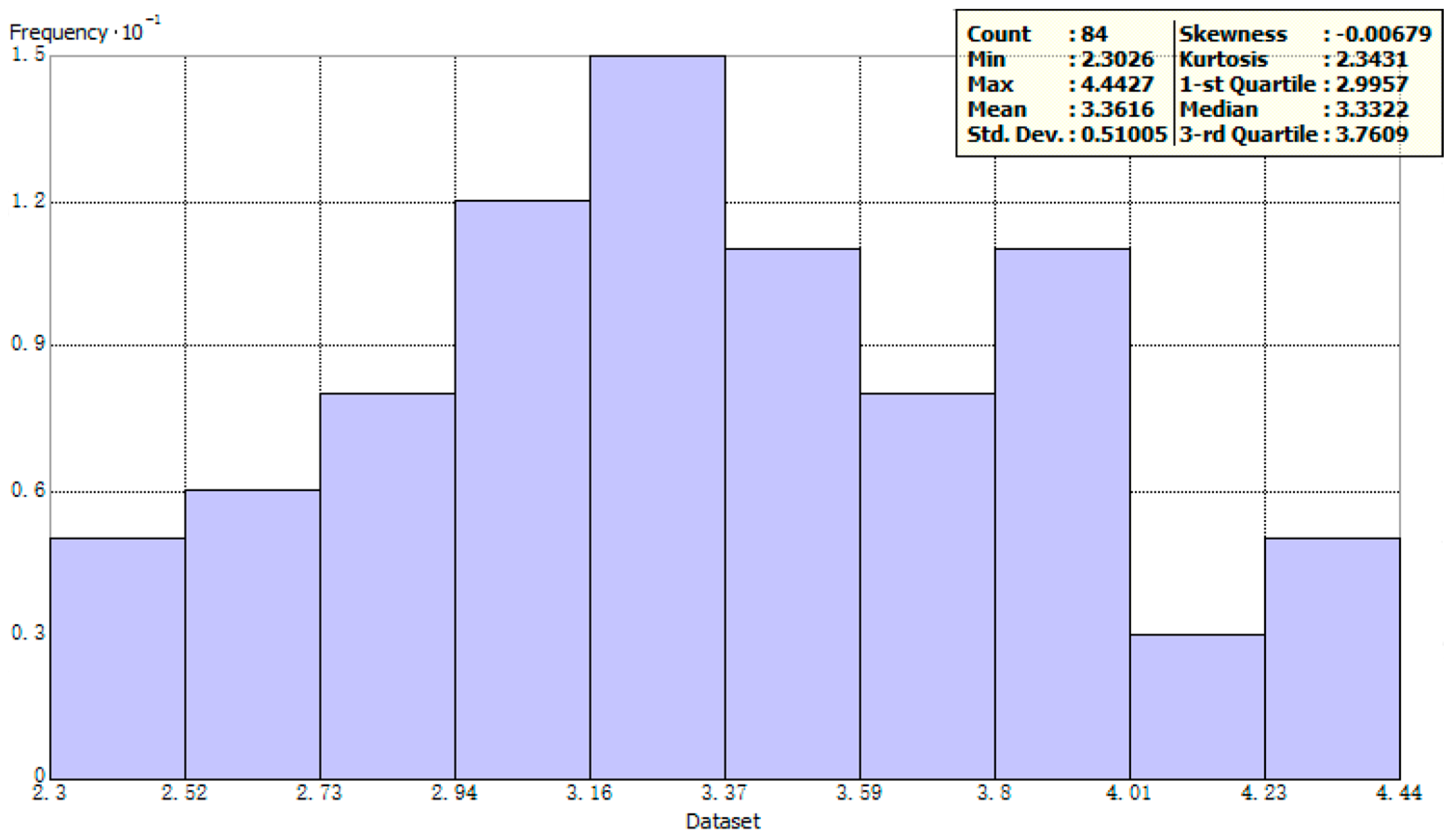
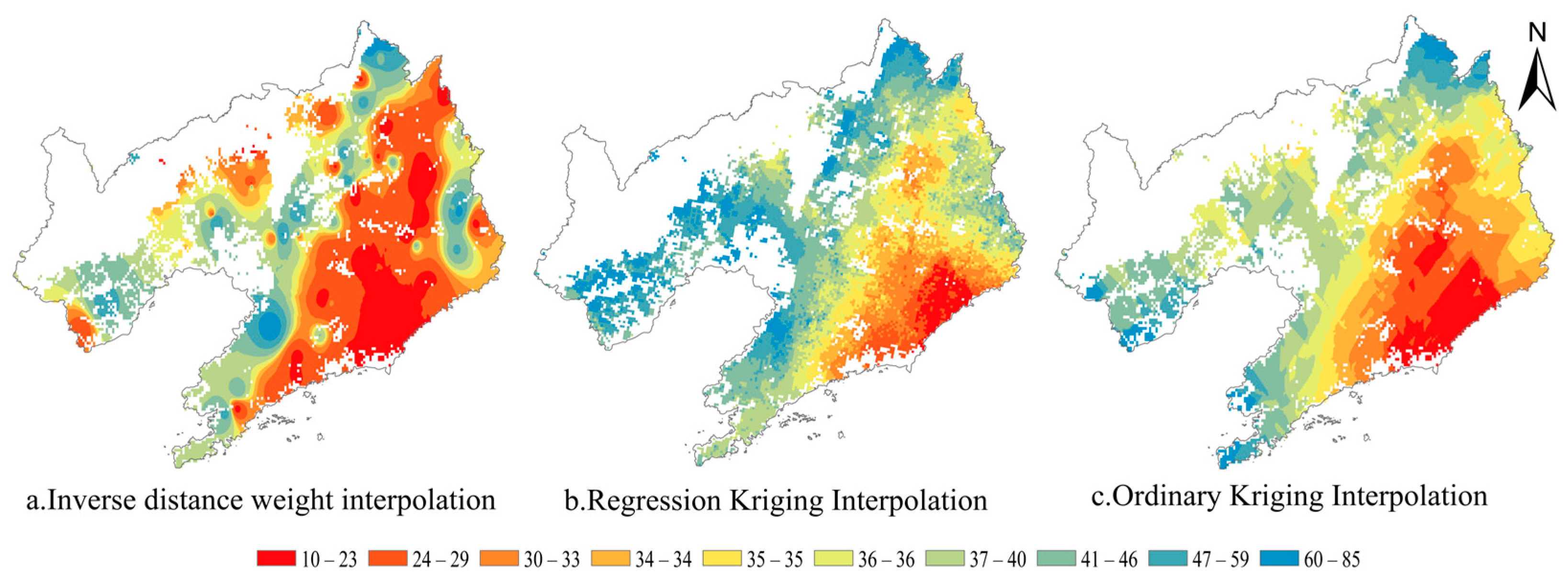
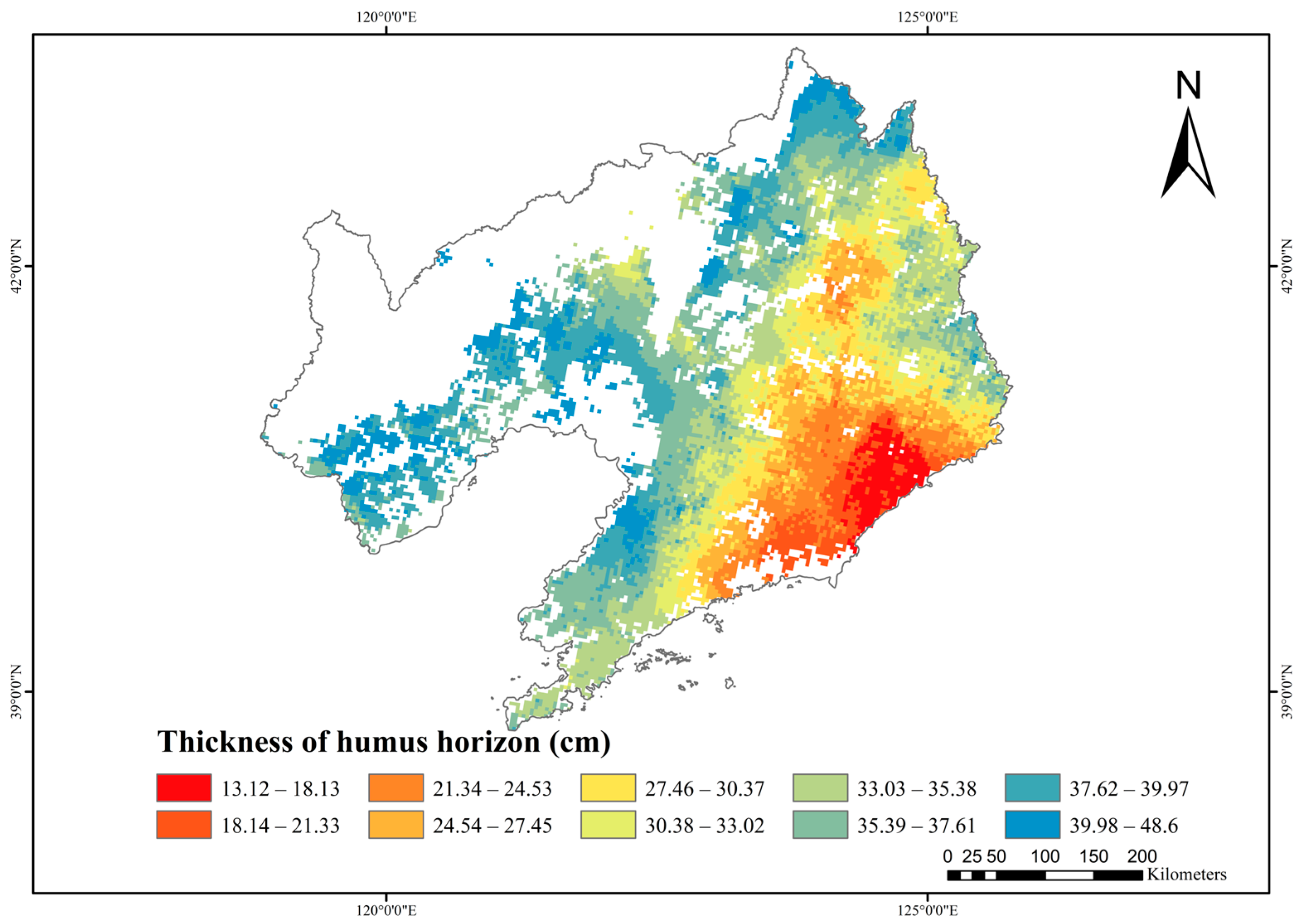
| Name | Minimum (cm) | Maximum (cm) | Mean (cm) | Median (cm) | SD (cm) | Variance (cm) | Kurtosis | Skewness | CV |
|---|---|---|---|---|---|---|---|---|---|
| The humus horizon thickness | 9.00 | 85.00 | 30.28 | 28.00 | 17.22 | 252.12 | 0.61 | 0.81 | 0.55 |
| Name | ME (cm) | MAE (cm) | RMSE (cm) | RRMSE (cm) |
|---|---|---|---|---|
| IDW | 13.81 | 13.81 | 18.08 | 0.56 |
| OK | 12.12 | 12.12 | 16.16 | 0.47 |
| RK | 11.45 | 11.45 | 14.98 | 0.44 |
| Name | Contribution |
|---|---|
| Average annual temperature | 0.29 |
| Average annual precipitation | 0.27 |
| DEM | 0.21 |
| Land use type | 0.12 |
| Geomorphology | 0.06 |
| Vegetation type | 0.05 |
Disclaimer/Publisher’s Note: The statements, opinions and data contained in all publications are solely those of the individual author(s) and contributor(s) and not of MDPI and/or the editor(s). MDPI and/or the editor(s) disclaim responsibility for any injury to people or property resulting from any ideas, methods, instructions or products referred to in the content. |
© 2024 by the authors. Licensee MDPI, Basel, Switzerland. This article is an open access article distributed under the terms and conditions of the Creative Commons Attribution (CC BY) license (https://creativecommons.org/licenses/by/4.0/).
Share and Cite
Jiang, Y.-Y.; Tang, J.-Y.; Sun, Z.-X. Study on the Factors Affecting the Humus Horizon Thickness in the Black Soil Region of Liaoning Province, China. Agronomy 2024, 14, 2106. https://doi.org/10.3390/agronomy14092106
Jiang Y-Y, Tang J-Y, Sun Z-X. Study on the Factors Affecting the Humus Horizon Thickness in the Black Soil Region of Liaoning Province, China. Agronomy. 2024; 14(9):2106. https://doi.org/10.3390/agronomy14092106
Chicago/Turabian StyleJiang, Ying-Ying, Jia-Yi Tang, and Zhong-Xiu Sun. 2024. "Study on the Factors Affecting the Humus Horizon Thickness in the Black Soil Region of Liaoning Province, China" Agronomy 14, no. 9: 2106. https://doi.org/10.3390/agronomy14092106
APA StyleJiang, Y.-Y., Tang, J.-Y., & Sun, Z.-X. (2024). Study on the Factors Affecting the Humus Horizon Thickness in the Black Soil Region of Liaoning Province, China. Agronomy, 14(9), 2106. https://doi.org/10.3390/agronomy14092106





